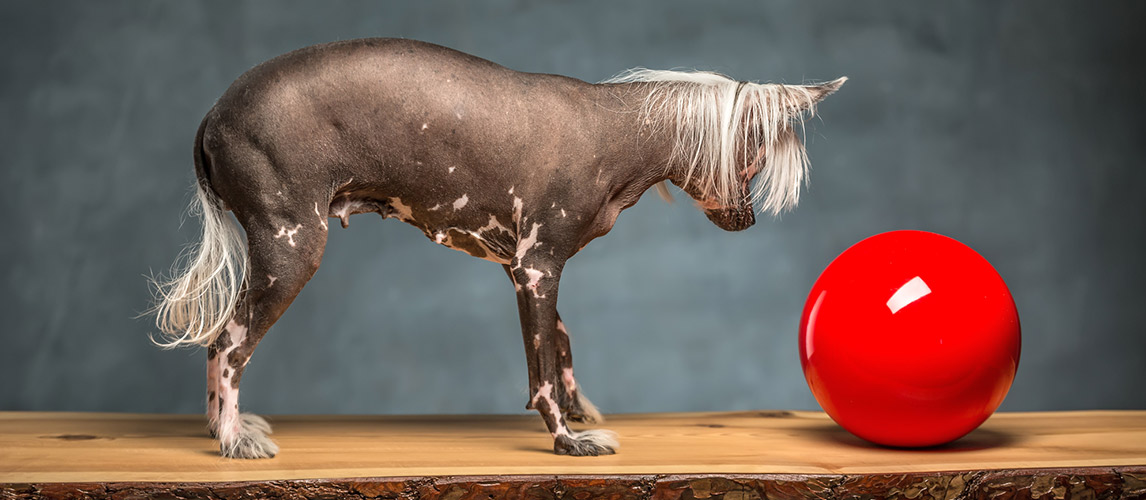As unfair as it is, hairless dog breeds certainly get a bad rap. Commonly described as either grumpy or ugly, it’s no wonder you don’t see many American hairless dogs wandering around our parks. However, this is a damn shame – not only do these dogs make for wonderful family pets as a result of their playful nature, members of these breeds are tremendously intelligent.
If you’re keen to buy a hairless dog yet are intimidated by the wide variety of hairless puppies out there, we’ve compiled a selection of the best hairless dog breeds about so you can decide which hairless dog will be the best fit for your lifestyle. Although you’ll certainly spend a colossal chunk of cash on dog sunscreen protecting your hairless dog’s sensitive skin, the amount of money is worth it to have such a family-oriented pup brighten up your home.
Chinese Crested
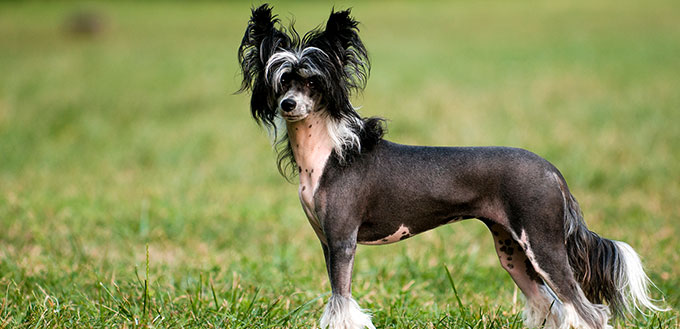 Similar to most hairless dog breeds, Chinese Crested dogs either come with or without fur. Both Powderpuffs (Chinese Crested dogs with hair) and Hairless Chinese Crested dogs are, interestingly enough, born in the same litter – although hairless Chinese Crested dogs are more common due to hypotrichosis (no hair growth) being caused by a single dominant gene. As dogs with two copies of the hypotrichosis gene are unable to survive past the embryonic stage, both Powerpuffs and hairless members of this breed must be produced for the Chinese Crested breed to survive.
Similar to most hairless dog breeds, Chinese Crested dogs either come with or without fur. Both Powderpuffs (Chinese Crested dogs with hair) and Hairless Chinese Crested dogs are, interestingly enough, born in the same litter – although hairless Chinese Crested dogs are more common due to hypotrichosis (no hair growth) being caused by a single dominant gene. As dogs with two copies of the hypotrichosis gene are unable to survive past the embryonic stage, both Powerpuffs and hairless members of this breed must be produced for the Chinese Crested breed to survive.
These poor hairless pups have been the brunt of jokes for their supposed “ugliness” for years. One particularly cruel example is the world’s denomination of hairless Chinese Crested purebred Sam as the World’s Ugliest Dog (2003-2005). This being said, it does seem as though purebred Sam was treated like a king by his devoted owner. We’re not overly surprised. Given the lively and affectionate nature of a stereotypical Chinese Crested dog, they’re a breed that captures the hearts of humans after only a few minutes in their company. Always up for snuggle on their owners’ laps due to their lack of body hair, this breed of dog makes for the perfect companion for movie nights!
American Hairless Terrier
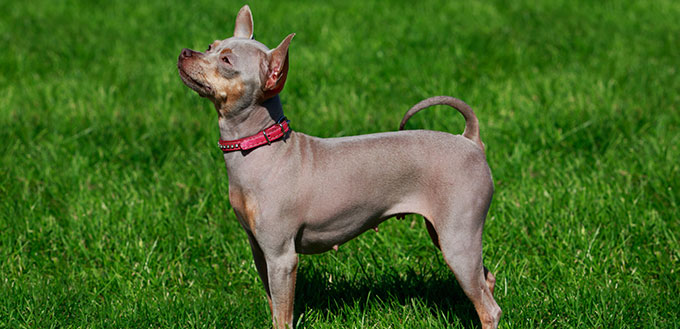 Originating from Louisiana, the American Hairless Terrier is an ideal choice to bring into any family home. Especially for those who suffer from dog hair allergies – these dogs are as hairless as any breed can get! The breed originated from the farm dogs Rat Terriers through somewhat of a happy accident: in 1972, as a hairless female puppy named Josephine was born into a Rat Terrier litter and subsequently bred.
Originating from Louisiana, the American Hairless Terrier is an ideal choice to bring into any family home. Especially for those who suffer from dog hair allergies – these dogs are as hairless as any breed can get! The breed originated from the farm dogs Rat Terriers through somewhat of a happy accident: in 1972, as a hairless female puppy named Josephine was born into a Rat Terrier litter and subsequently bred.
Although they possess next to no hair, an average American Hairless Terrier makes up for this in personality. Mischievous, confident, and energetic are only a few of the words that spring to mind when thinking of this hairless breed of dog. Even nowadays, this breed of terrier is rare, but we predict that their numbers will only grow as the dog world comes to discover their wonderful temperament.
Peruvian Inca Orchid
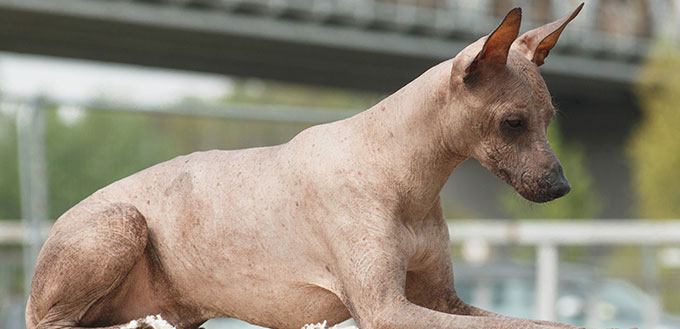 Holding the prestigious title of Peru’s national dog, the Peruvian Inca Orchid has a reputation to uphold. But with their quirky personality, they do so with ease. Researchers believe this ancient breed to have existed since the bygone days of 750 CE due to the dogs’ appearance on Incan pottery emerging as evidence of their existence. However, when Peru was conquered by the Conquistadors, Peruvian Inca Orchids were inbred with their dogs, resulting in the breed having three distinctive sizes of Inca Orchids. The breed arrived in America in 1966 and have spread across the globe since then. Although not as popular as hairy breeds like Golden Retrievers, the range of sizes that these hairless dogs come in has worked in the breed’s favor. Owners who prefer small dogs and those who prefer larger canines are both satisfied by these loyal pups.
Holding the prestigious title of Peru’s national dog, the Peruvian Inca Orchid has a reputation to uphold. But with their quirky personality, they do so with ease. Researchers believe this ancient breed to have existed since the bygone days of 750 CE due to the dogs’ appearance on Incan pottery emerging as evidence of their existence. However, when Peru was conquered by the Conquistadors, Peruvian Inca Orchids were inbred with their dogs, resulting in the breed having three distinctive sizes of Inca Orchids. The breed arrived in America in 1966 and have spread across the globe since then. Although not as popular as hairy breeds like Golden Retrievers, the range of sizes that these hairless dogs come in has worked in the breed’s favor. Owners who prefer small dogs and those who prefer larger canines are both satisfied by these loyal pups.
The breed being rare evidently means the price for a Peruvian Inca Orchid puppy is high at $600-$800 dollars. However, we believe this is a small price to pay for dogs so loving that were used as bed warmers during harsh Peruvian winters. Plus, their unusual flat feet with webbed toes make for a talking point when out on dog walks! The breed may well be native to the Andes, yet thanks to domestication they equally will feel as at home snuggled up on your sofa.
Xoloitzcuintli
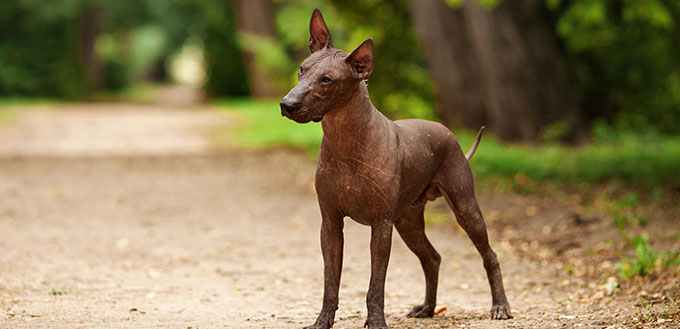 Yeah, their name is a bit of a mouthful. But this beautiful breed, otherwise known as the Mexican hairless dog, has a rich history. As the Xoloitzcuintli breed have been around for 3,000 years, dogs of this breed have ultimately developed into kind dogs boasting an even temperament. The breed name (pronounced “show-low-eats-queent-lee”, with an emphasis on the “queent”) was actually after the Aztecs’ dog-headed god, Xolotl. The breed were held in such high regard among Aztecs that once a prominent member of the nomadic tribe died, their Xoloitzcuintli would be sacrificed to be buried alongside their owners.
Yeah, their name is a bit of a mouthful. But this beautiful breed, otherwise known as the Mexican hairless dog, has a rich history. As the Xoloitzcuintli breed have been around for 3,000 years, dogs of this breed have ultimately developed into kind dogs boasting an even temperament. The breed name (pronounced “show-low-eats-queent-lee”, with an emphasis on the “queent”) was actually after the Aztecs’ dog-headed god, Xolotl. The breed were held in such high regard among Aztecs that once a prominent member of the nomadic tribe died, their Xoloitzcuintli would be sacrificed to be buried alongside their owners.
Although sacrificing members of this ancient dog breed is thankfully no longer customary, a typical Xoloitzcuintli is still a faithful watchdog and companion to their family members, whom they cherish and love. In particular, Xoloitzcuintli dogs have a strong affinity with children of their family.
Abyssinian Sand Terrier
Unusually, nobody knows for sure where the Abyssinian Sand Terrier breed originated, but experts believe them to have developed in Africa. Not much is known about the indigenous dog breed, apart from the breed being thought to possess magical powers. Members of the breed are certainly distinctive, with their elephant or sandy color of fur.
Unfortunately, Abyssinian Sand Terriers are now extinct. Although extinction is by far the most likely outcome, many dog experts live in hope that the fact that no extensive search for members of the breed has been conducted across Africa mean that some Sand Terriers are still out there somewhere. Let’s hope so, as we’d love to discover the temperament of the Abyssinian Sand Terrier for ourselves!
Jonangi Dog
As one of many of India’s hairless dog breeds, the Jonangi is itself distinctive. Due to their very long legs when compared to their short body, Jonangi dogs can cover long distances in a very short space of time. Another remarkable characteristic of Jonangi dogs is their adorable wrinkled foreheads. Accompanied by their tulip-shaped ears, dogs belonging to this native breed seem as though they’re always mulling over something or other!
Out of all the Jonangi’s distinctive characteristics, its tendency to “yodel” emerges as the most extraordinary. Its rare bark is one of the reasons why members of this Indian dog breed made such great duck herders back in the day. However, as duck herding died out and Jonangi dogs were no longer required, they were released into the wild. However, it was their success in the wild that has ultimately led to their near extinction. The breed’s astute fishing strategy aggravated aquaculture farmers to such an extent that the breed are now killed by the same people they used to help herd ducks.
Hairless Khala
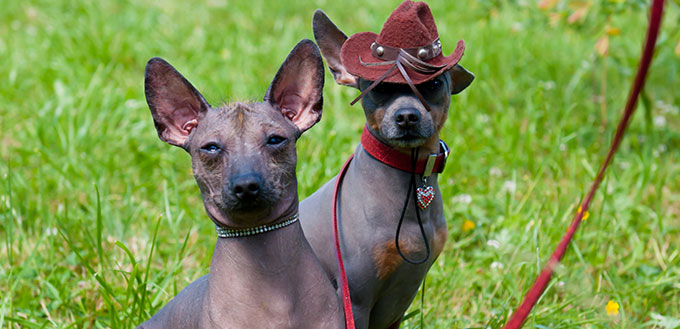 Even the breed’s name is distinctive – the Bolivian Quechua Indian term “Khala” actually means “no clothing” which, put differently, indicates their absence of fur. Like many dogs with no hair, there are two varieties of Khala
Even the breed’s name is distinctive – the Bolivian Quechua Indian term “Khala” actually means “no clothing” which, put differently, indicates their absence of fur. Like many dogs with no hair, there are two varieties of Khala
If you’re considering welcoming a hairless Khala into your family home, chances are you won’t have to pay much for them in veterinary bills. As these small hairless dogs originate from India – a nation where 31.1% of the population survived on $1.90 a day according to World Bank data – members of the breed nowadays are naturally healthy, given the fact that their ancestors survived without veterinary attention. However, owning a Khala is a challenge in other ways. These furless dogs have a tendency to develop small dog syndrome if allowed to run riot, so remember to keep them in check!
Argentine Pila Dog
As can be gathered from their name, the breed originate from Argentina and are related to other hairless dog breeds in South America like the Peruvian Inca Orchid dog, which is why no major kennel clubs acknowledge them. Interestingly enough, it is presumed that the hairless dog breed arrived in the country as a gift from the Incan Empire in an attempt to strengthen political ties. Given the dramatic resemblance of the two hairless dog breeds, we are inclined to believe this rumor.
Just like their Peruvian Inca Orchid cousins, Argentine Pila dogs were also used as hairless water bottles to warm up their owners in harsh winter months. Prized for their remarkably soft skin, owners must pay attention to how much sun exposure their Argentine Pila dog’s skin is subjected to. Make sure to use SPF products to keep their hairless skin hydrated at all times – especially to protect lighter-colored dogs’ skin!
Sources:
- Hairless Dog Breeds – The American Kennel Club
- Heidi G. Parker, The Bald And The Beautiful: Hairlessness In Domestic Dog Breeds – The Royal Society
- Doriane Raiman, Westminster Dog Show: Introducing The Xoloitzcuintli – NPR

